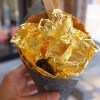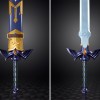The attraction will task guests with navigating a compound using their wits and spy skills and will even feature a laser tripwire obstacle course. A LASER TRIPWIRE OBSTACLE COURSE!
spy
Thanks to years of espionage and international intrigue, Hattifatteners and Snufkin were first brought to Japan.
As many of you probably already know, protests are going on in Hong Kong as a portion of its citizens are demanding for electoral democracy. The protest, which began on 26 September, triggered off a chain of events, from students boycotting classes, to thousands of people occupying several major areas of the bustling city in demonstration, to mysterious flying objects, and now, mysterious doppelgängers.
The Japanese translation of a recent book by Glenn Greenwald covering his involvement in the events surrounding Edward Snowden’s release of thousands of classified US government documents is set to hit stores on 14 May. As a result, an excerpt from the book was released to the Japanese media, whetting readers’ appetites by mentioning the role Japan played in his decision to turn himself into what some consider an enemy of his state.
On the surface, Japan’s role was fairly incidental. However, the slightly new info helped to reignite an older dispute over the nation’s lack of any sort of substantial anti-espionage laws.
If you happened to have been around the West Exit of Shinjuku Station this week you might have seen this poster hanging around. In it we can clearly see a photo of Prime Minister Shinzo Abe done up to look like Charlie Chaplin in the film The Great Dictator. Around him are the words “Take back Japan” and “Prewar.”
In one of the strangest stories we’ve come across so far this week – yes, stranger than exploding yogurt and ramen cake – reports are coming in of a number of Chinese-made irons that contain “mini microphones” and chips that can plant viruses in nearby computer equipment via home Wi-Fi networks.
We always knew ironing sucked, but this is ridiculous.






 Starbucks Japan reveals new winter holiday goods to wrap up 2024
Starbucks Japan reveals new winter holiday goods to wrap up 2024 Station of despair: What to do if you get stuck at the end of Tokyo’s Chuo Rapid Line
Station of despair: What to do if you get stuck at the end of Tokyo’s Chuo Rapid Line Tokyo’s Super Mario Christmas decoration displays are super cool【Photos】
Tokyo’s Super Mario Christmas decoration displays are super cool【Photos】 Ramen restaurant etiquette reminder follows altercation with angry couple: One person, one bowl
Ramen restaurant etiquette reminder follows altercation with angry couple: One person, one bowl Japanese train station vending machine has the best souvenirs for rail otaku
Japanese train station vending machine has the best souvenirs for rail otaku Cup Noodle sells new squid fork with its instant ramen
Cup Noodle sells new squid fork with its instant ramen Sailor Moon and J-pop mega-star Ayumi Hamasaki team up for collaboration, pre-defeat scalpers
Sailor Moon and J-pop mega-star Ayumi Hamasaki team up for collaboration, pre-defeat scalpers Totoro towels gently glow in the dark to set the Ghibli nighttime mood in your home【Photos】
Totoro towels gently glow in the dark to set the Ghibli nighttime mood in your home【Photos】 Serpentine Winnie the Pooh Year of the Snake plushies, Mickey and Baymax daruma arrive in Japan
Serpentine Winnie the Pooh Year of the Snake plushies, Mickey and Baymax daruma arrive in Japan We eat gold-leaf “Kinkaku Soft Ice Cream” near Kinkakuji Golden Pavillion temple in Kyoto
We eat gold-leaf “Kinkaku Soft Ice Cream” near Kinkakuji Golden Pavillion temple in Kyoto This downtown Tokyo cafe is like a time machine that takes you back 50 years into the past
This downtown Tokyo cafe is like a time machine that takes you back 50 years into the past Major Japanese city is abolishing extracurricular activities at all of its middle schools
Major Japanese city is abolishing extracurricular activities at all of its middle schools Japanese company develops classy heavy metal band frames for glasses
Japanese company develops classy heavy metal band frames for glasses Japanese government will check and judge new baby name pronunciations, presents guidelines
Japanese government will check and judge new baby name pronunciations, presents guidelines Shakey’s is back! All-you-can-eat pizza chain returns to downtown Tokyo’s Shinjuku
Shakey’s is back! All-you-can-eat pizza chain returns to downtown Tokyo’s Shinjuku Studio Ghibli showcases traditional craftsmanship with new wallet range
Studio Ghibli showcases traditional craftsmanship with new wallet range Possessing Harry Potter’s Sword of Godric Gryffindor is now illegal in Japan
Possessing Harry Potter’s Sword of Godric Gryffindor is now illegal in Japan Uniqlo announces first-ever collaboration with horror manga master Junji Ito【Photos】
Uniqlo announces first-ever collaboration with horror manga master Junji Ito【Photos】 J-pop mega star Ado reveals she’s been living in the U.S., may not understand language acquisition
J-pop mega star Ado reveals she’s been living in the U.S., may not understand language acquisition Starbucks Japan is calling it quits with paper straws
Starbucks Japan is calling it quits with paper straws Japan’s most popular castle raising ticket prices by up to 200 percent for non-local tourists
Japan’s most popular castle raising ticket prices by up to 200 percent for non-local tourists Furikake rice seasoning sales are soaring, which is bad news for Japan as a whole
Furikake rice seasoning sales are soaring, which is bad news for Japan as a whole Studio Ghibli heroine cardigans give you warmth and strength to face everyday challenges
Studio Ghibli heroine cardigans give you warmth and strength to face everyday challenges Eight unforgettable hot springs, as recommended by Japan’s “Professor Bath”
Eight unforgettable hot springs, as recommended by Japan’s “Professor Bath” McDonald’s new Happy Meals offer up cute and practical Sanrio lifestyle goods
McDonald’s new Happy Meals offer up cute and practical Sanrio lifestyle goods Foreign tourists on Shinkansen bullet train break suitcase etiquette, angering local passengers
Foreign tourists on Shinkansen bullet train break suitcase etiquette, angering local passengers [Deleted] Article written for April Fool’s Day 2018
[Deleted] Article written for April Fool’s Day 2018 Japanese government to make first change to romanization spelling rules since the 1950s
Japanese government to make first change to romanization spelling rules since the 1950s Foreigner’s request for help in Tokyo makes us sad for the state of society
Foreigner’s request for help in Tokyo makes us sad for the state of society Japanese convenience store Family Mart announces abolishment of eat-in spaces
Japanese convenience store Family Mart announces abolishment of eat-in spaces Life-size vibrating Legend of Zelda Master Sword for sale from Nintendo【Photos】
Life-size vibrating Legend of Zelda Master Sword for sale from Nintendo【Photos】 Princesses, fruits, and blacksmiths: Study reveals the 30 most unusual family names in Japan
Princesses, fruits, and blacksmiths: Study reveals the 30 most unusual family names in Japan Studio Ghibli releases free-download board game — Here’s how to play it without reading Japanese
Studio Ghibli releases free-download board game — Here’s how to play it without reading Japanese Cup Noodle sells new squid fork with its instant ramen
Cup Noodle sells new squid fork with its instant ramen Sailor Moon and J-pop mega-star Ayumi Hamasaki team up for collaboration, pre-defeat scalpers
Sailor Moon and J-pop mega-star Ayumi Hamasaki team up for collaboration, pre-defeat scalpers Totoro towels gently glow in the dark to set the Ghibli nighttime mood in your home【Photos】
Totoro towels gently glow in the dark to set the Ghibli nighttime mood in your home【Photos】 Serpentine Winnie the Pooh Year of the Snake plushies, Mickey and Baymax daruma arrive in Japan
Serpentine Winnie the Pooh Year of the Snake plushies, Mickey and Baymax daruma arrive in Japan We eat gold-leaf “Kinkaku Soft Ice Cream” near Kinkakuji Golden Pavillion temple in Kyoto
We eat gold-leaf “Kinkaku Soft Ice Cream” near Kinkakuji Golden Pavillion temple in Kyoto Ramen restaurant in Kyoto offers all-you-can-eat toppings and side dishes for free
Ramen restaurant in Kyoto offers all-you-can-eat toppings and side dishes for free Is the all-you-can-eat KFC buffet in Tokyo really as good as they say it is?
Is the all-you-can-eat KFC buffet in Tokyo really as good as they say it is? Starbucks Japan has a miniature collection, but you’ll need patience to get it
Starbucks Japan has a miniature collection, but you’ll need patience to get it We visit the 24-hour male-only sauna just outside of Hakata Station and ponder a strange sight
We visit the 24-hour male-only sauna just outside of Hakata Station and ponder a strange sight 100-year-old brush shop in Tokyo sells a Japanese body brush that’s painfully good
100-year-old brush shop in Tokyo sells a Japanese body brush that’s painfully good 10 gorgeous, must-visit places to see the autumn leaves in Japan
10 gorgeous, must-visit places to see the autumn leaves in Japan Studio Ghibli tea blends contain ingredients inspired by My Neighbour Totoro
Studio Ghibli tea blends contain ingredients inspired by My Neighbour Totoro Shedding some light on the crazy bright flashlights advertised on Twitter
Shedding some light on the crazy bright flashlights advertised on Twitter Osaka governor suggests lowering voting age to 0 to curb population decline
Osaka governor suggests lowering voting age to 0 to curb population decline